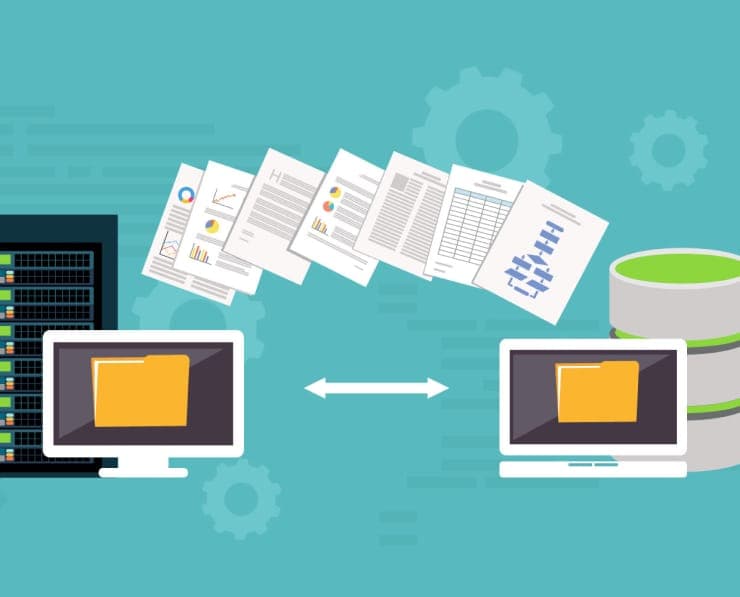Student Feedback
70-741: MCSA Networking with Windows Server 2016 Certification Video Training Course Outline
Welcome
Learning IPv4 and IPv6
Learning DHCP
Welcome
70-741: MCSA Networking with Windows Server 2016 Certification Video Training Course Info
Learn Networking in Windows Server 2016 – Microsoft 70-741 Online Course
Master Networking Skills in Windows Server 2016 – MCSA Program
What You Will Learn From This Course
Gain practical knowledge of planning, deploying, and managing network infrastructures using Windows Server 2016
Understand Domain Name System (DNS) and learn how to configure and manage it in enterprise environments.
Implement Dynamic Host Configuration Protocol (DHCP) and IP Address Management (IPAM) to automate network administration tasks.
Configure and manage remote access solutions, including VPN and DirectAccess, for secure connectivity
Deploy core and distributed network solutions across multiple si.tes
Learn advanced networking technologies such as Software Defined Networking (SDN)
Design network infrastructures with strong security controls and redundancy
Develop skills to troubleshoot, monitor, and optimize network performance in Windows Server 2016
Prepare for the Microsoft 70-741 exam with a focus on real-world scenarios and hands-on exercises. ises
Enhance career prospects for network administrators, IT professionals, and system engineers.
Learning Objectives
By completing this course, learners will be able to:
Explain networking concepts and TCP/IP fundamentals relevant to Windows Server 2016
Plan and implement DNS zones, records, and policies to support enterprise network operations.
Configure DHCP scopes, reservations, failover, and integrate IPAM for centralized management
Establish and manage remote access solutions, including VPN, DirectAccess, and RADIUS authentication.
Deploy and maintain network services across multiple Windows Server 2016 servers.s
Understand and implement network virtualization and Software Defined Networking solutions.
Apply best practices for network security, access control, and monitoring.
Analyze and troubleshoot common network problems using the built-in Windows Server tool.s
Integrate core networking services with Active Directory and other enterprise systems.ms
Prepare effectively for the MCSA: Windows Server 2016 70-741 certification exam.
Target Audience
This course is designed for IT professionals, network administrators, and system engineers who are involved in enterprise network operations. The ideal audience includes:
Network administrators looking to strengthen their skills in managing Windows Server 2016 networks
IT professionals seeking to gain hands-on knowledge of advanced networking technologies
Candidates preparing for the Microsoft 70-741 certification exam
System engineers responsible for deploying, configuring, and maintaining network services in medium to large enterprises
Professionals aiming to advance their careers in network administration or cloud infrastructure management.
Requirements
This course covers essential networking skills and advanced concepts, requiring learners to have prior practical experience in IT environments. Requirements include:
Hands-on experience with network administration tasks in enterprise settings
Basic knowledge of TCP/IP networking concepts, including IP addressing and routing
Familiarity with Windows Server operating systems and core services
Understanding of networking protocols and services such as DNS, DHCP, and IPAM
Awareness of remote access solutions, including VPN, DirectAccess, and RADIUS
Basic understanding of security concepts and network troubleshooting
Prerequisites
Before starting this course, learners should meet the following prerequisites:
Experience performing network-related tasks in an IT environment
Familiarity with Windows Server management and administration
Basic understanding of networking concepts, including IP addressing, DNS, DHCP, and routing
Awareness of enterprise network requirements and remote access technologies
Familiarity with virtualization and server deployment practices
General understanding of security principles and network monitoring
This course begins with foundational networking concepts in Windows Server 2016, including an overview of TCP/IP and DNS. Learners will then progress to configuring and managing DHCP, IPAM, and other essential network services. The course emphasizes practical application, with real-world scenarios designed to reinforce learning and prepare participants for the 70-741 certification exam. Advanced topics such as Software Defined Networking, network virtualization, and enterprise-level network security are introduced to provide learners with a comprehensive skill set. By the end of this part, participants will have a clear understanding of core network components, the role of DNS and DHCP in enterprise environments, and the tools available to monitor, manage, and optimize Windows Server 2016 networks.
Participants will develop the ability to plan network topologies, configure and manage servers, and integrate network services across multiple sites. Emphasis is placed on practical exercises and hands-on labs to ensure learners gain experience configuring and troubleshooting network services. Remote access technologies, including VPN and DirectAccess, are covered to provide learners with the skills needed to support secure connectivity for users and devices. Advanced features, such as network virtualization, are explored to demonstrate how modern networking technologies are implemented in Windows Server 2016 environments.
The course also provides insight into designing networks with security and reliability in mind. Best practices for access control, monitoring, and redundancy are discussed to help learners create robust enterprise network infrastructures. Learners are encouraged to explore troubleshooting techniques to identify and resolve network issues efficiently. The integration of networking services with Active Directory and other enterprise systems is highlighted to show how core network components interact within a Windows Server 2016 environment.
Course Modules / Sections
The Networking with Windows Server 2016 course is organized into several modules designed to progressively build expertise in configuring, deploying, and managing enterprise network solutions. Each module focuses on practical skills and conceptual knowledge required for the 70-741 certification exam.
The first module introduces the foundational concepts of Windows Server 2016 networking, including TCP/IP fundamentals, network protocols, and addressing schemes. Learners gain a clear understanding of the essential building blocks of networking and how these elements interact within Windows Server environments.
The second module covers Domain Name System (DNS) in detail. Topics include planning DNS zones, creating records, configuring forwarders and conditional forwarding, and integrating DNS with Active Directory. Practical exercises demonstrate real-world deployment scenarios, allowing learners to configure DNS servers to support enterprise networks effectively.
The third module focuses on Dynamic Host Configuration Protocol (DHCP) and IP Address Management (IPAM). Participants learn how to create and manage DHCP scopes, reservations, and options, implement failover for high availability, and integrate IPAM for centralized IP address management. This module emphasizes automation and monitoring to streamline network administration tasks.
The fourth module explores remote access technologies in Windows Server 2016. Key topics include Virtual Private Network (VPN) configuration, DirectAccess deployment, and network policy server (NPS) setup for RADIUS authentication. Learners understand how to provide secure connectivity for users and devices across local and wide area networks.
The fifth module covers network services deployment and configuration, including core and distributed network services. Participants learn to implement network load balancing, failover clustering, and redundancy to ensure high availability and reliability in enterprise environments.
The sixth module introduces Software Defined Networking (SDN) and network virtualization. This advanced module explores virtual network infrastructure design, implementation, and management using Windows Server 2016 technologies. Learners gain insight into creating scalable, flexible, and automated networks to meet modern enterprise requirements.
The final module focuses on network security and monitoring. Learners study techniques for securing network traffic, implementing access control, configuring firewalls, and monitoring performance using built-in Windows Server tools. Emphasis is placed on troubleshooting, proactive monitoring, and optimizing network operations.
Key Topics Covered
This course covers a comprehensive set of topics that equip IT professionals with the skills needed to manage complex Windows Server 2016 networks. Key topics include:
TCP/IP fundamentals and network protocol concepts
IP addressing schemes, subnetting, and routing fundamentals
Planning, configuring, and managing DNS zones, records, and policies
Integrating DNS with Active Directory for enterprise network management
Configuring DHCP scopes, options, reservations, and failover
Implementing IPAM for centralized IP address management
Deploying and managing VPNs and DirectAccess for secure remote access
Configuring RADIUS authentication and network policy server (NPS) roles
Implementing core and distributed network services
Network load balancing, failover clustering, and redundancy solutions
Advanced network design with Software Defined Networking (SDN)
Network virtualization using Windows Server 2016 features.
Securing network infrastructure through access control, firewall configuration, and traffic monitoring
Troubleshooting network issues using Windows Server diagnostic tools
Monitoring and optimizing network performance and reliability
Planning and deploying scalable, enterprise-level network solutions
Through these topics, learners develop the skills required to deploy and manage a robust Windows Server 2016 network infrastructure. Emphasis on hands-on practice ensures learners can apply their knowledge in real-world enterprise environments.
Teaching Methodology
The course follows a practical, hands-on teaching methodology designed to reinforce conceptual knowledge with real-world application. The approach combines theory, demonstrations, and guided exercises to ensure learners understand both how and why networking tasks are performed in Windows Server 2016 environments.
Theoretical lessons provide in-depth explanations of networking concepts, protocols, and services, helping learners understand the principles behind network design and implementation. Each topic is explained using examples that reflect enterprise scenarios, allowing learners to see the relevance of skills in professional settings.
Demonstrations are conducted using Windows Server 2016 lab environments, showing step-by-step procedures for configuring DNS, DHCP, IPAM, VPNs, DirectAccess, and other network services. Learners observe practical implementations and understand the potential challenges and solutions in real-world networks.
Hands-on exercises are a key component of the teaching methodology. Learners perform tasks such as creating DNS zones, configuring DHCP failover, deploying remote access solutions, and implementing SDN in lab environments. These exercises reinforce understanding and build confidence in performing network tasks independently.
Scenario-based learning is incorporated to simulate enterprise networking challenges. Learners are presented with real-world problems and tasked with designing, implementing, and troubleshooting network solutions. This approach encourages critical thinking and problem-solving skills while preparing participants for the types of challenges they may face in their careers.
Interactive discussions and feedback sessions are conducted throughout the course to address learners’ questions, clarify concepts, and provide guidance on best practices. Instructors share insights from practical experience and provide tips for efficient network administration and troubleshooting.
Assessment-oriented teaching ensures that learners are prepared for the 70-741 certification exam. Each module includes exercises that mirror exam scenarios, allowing participants to test their knowledge and skills. Progress is continuously monitored to identify areas that may require additional focus.
By combining theory, demonstrations, hands-on practice, scenario-based learning, and continuous feedback, the course ensures that learners develop both practical skills and conceptual understanding required for managing Windows Server 2016 networks.
Assessment & Evaluation
The course uses a structured assessment and evaluation strategy to measure learner progress and ensure mastery of networking concepts and skills. Assessments are designed to reflect the real-world tasks and exam objectives of the 70-741 certification.
Practical assessments form a significant portion of the evaluation. Learners are required to configure DNS zones, DHCP scopes, and IPAM, deploy VPN and DirectAccess solutions, and implement network virtualization using SDN features. These assessments test the ability to perform network tasks accurately and efficiently in simulated enterprise environments.
Knowledge checks are conducted after each module to evaluate understanding of theoretical concepts. These include multiple-choice questions, scenario-based problem-solving exercises, and practical demonstrations. Learners receive immediate feedback to reinforce learning and address any knowledge gaps.
Scenario-based assessments present learners with complex networking challenges that require integrating multiple skills. Participants must plan network designs, implement configurations, troubleshoot issues, and optimize performance. These exercises assess both technical proficiency and problem-solving capabilities.
Progress evaluations are conducted throughout the course, allowing instructors to monitor learner performance and provide personalized guidance. Areas of strength and weakness are identified, and additional resources or exercises are provided to ensure a comprehensive understanding.
Final evaluations combine practical tasks, knowledge checks, and scenario-based exercises to determine overall competency. Successful completion demonstrates readiness to manage Windows Server 2016 network infrastructures and prepares learners for the 70-741 exam.
Continuous self-assessment is encouraged throughout the course. Learners are guided to document configurations, reflect on problem-solving approaches, and review key concepts regularly. This practice ensures retention of knowledge and reinforces the application of skills in real-world environments.
By integrating practical, scenario-based, and knowledge-based assessments, the course provides a holistic evaluation approach. Participants gain confidence in their abilities, ensuring they are prepared to deploy, manage, and troubleshoot enterprise networks using Windows Server 2016.
The combination of structured course modules, comprehensive topic coverage, practical teaching methodology, and robust assessment ensures that learners gain both the knowledge and hands-on experience necessary to excel as network administrators and IT professionals. Completing this part of the series equips learners with the expertise to handle advanced networking tasks, deploy secure and reliable networks, and prepare effectively for the Microsoft 70-741 certification exam.
Benefits of the Course
Completing the Networking with Windows Server 2016 course provides a range of professional and technical benefits that enhance career growth and practical expertise. The course is designed to equip learners with the skills necessary for managing, deploying, and optimizing network infrastructures in enterprise environments.
One of the primary benefits is the ability to gain in-depth knowledge of Windows Server 2016 networking features. Learners acquire practical skills in configuring DNS, DHCP, IPAM, remote access solutions, and Software Defined Networking. These skills allow IT professionals to manage complex networks efficiently and effectively.
The course also prepares participants for the Microsoft 70-741 certification exam. By aligning the curriculum with exam objectives, learners gain both theoretical understanding and hands-on experience required to successfully achieve certification. This certification enhances credibility and recognition in the IT industry.
Another significant benefit is career advancement opportunities. The skills learned in this course are highly relevant for network administrators, IT support specialists, and system engineers. Completing the course demonstrates proficiency in managing enterprise network infrastructures, which is often a requirement for higher-level positions in IT management.
Learners also gain the ability to design, deploy, and troubleshoot advanced network solutions. This includes implementing network security measures, ensuring high availability through failover clustering and load balancing, and deploying remote access solutions. The practical, scenario-based approach ensures learners can apply these skills in real-world environments.
The course emphasizes automation and efficiency through IP Address Management and centralized network administration. Learners gain knowledge of monitoring tools, network optimization techniques, and troubleshooting strategies that reduce downtime and improve network performance.
Furthermore, participants develop expertise in advanced technologies such as network virtualization and Software Defined Networking. These skills are increasingly valuable in modern enterprise environments and cloud-integrated infrastructures.
Finally, the course enhances problem-solving capabilities. Scenario-based learning and practical labs prepare learners to identify, analyze, and resolve network issues quickly and efficiently. This combination of technical skills, certification preparation, and practical application makes the course highly beneficial for career growth and professional development in networking and IT management.
Course Duration
The Networking with Windows Server 2016 course is designed to provide comprehensive training over a structured period. The total duration is typically between 40 and 50 hours, depending on the learner’s pace and engagement with practical exercises.
The course is divided into multiple modules that cover foundational, intermediate, and advanced networking concepts. Each module is allocated sufficient time to ensure learners can understand theory, observe demonstrations, and complete hands-on exercises.
Foundational modules, including TCP/IP concepts and DNS configuration, usually require 8 to 10 hours of focused study. These modules establish the core knowledge necessary for understanding more advanced networking tasks.
Intermediate modules, including DHCP, IPAM, and remote access technologies, take approximately 12 to 15 hours to complete. These sections provide practical experience in configuring and managing network services and include exercises to simulate real-world enterprise scenarios.
Advanced modules, covering Software Defined Networking, network virtualization, security, and monitoring, require an additional 12 to 15 hours. These modules focus on designing and deploying complex network infrastructures while emphasizing security, redundancy, and performance optimization.
Hands-on labs and scenario-based exercises are embedded throughout the course and contribute significantly to the overall duration. Learners are encouraged to practice configurations, troubleshoot issues, and explore advanced networking techniques, ensuring comprehensive skill development.
The flexible structure allows learners to progress at their own pace, with the option to revisit modules or exercises for additional practice. This duration ensures that participants have ample time to gain proficiency in both theoretical concepts and practical skills necessary for managing enterprise networks and preparing for the 70-741 certification exam.
Tools & Resources Required
To maximize learning and practical experience, participants are recommended to use specific tools and resources while completing the course. These tools support hands-on exercises, simulations, and real-world networking practice.
Windows Server 2016 is the primary platform for the course. Learners should have access to one or more Windows Server 2016 installations, either on physical hardware or through virtual machines, to complete configuration and deployment exercises. A virtual lab environment using software such as Hyper-V or VMware Workstation is highly recommended for flexibility and safety during practical exercises.
Network simulation tools and virtual networking environments are essential for testing configurations, deploying remote access solutions, and implementing Software Defined Networking scenarios. Tools like Hyper-V Virtual Switch, Virtual Network Manager, and Windows PowerShell are integral for network setup, automation, and management.
Administrative privileges are required to configure network services and make system-level changes during exercises. Participants should ensure they have appropriate permissions in their lab environment to deploy services, configure DNS and DHCP, and perform remote access setups.
Documentation and reference materials, including Microsoft official guides, configuration manuals, and lab exercise instructions, are recommended for learners to reinforce theoretical concepts and support hands-on practice. These resources provide step-by-step guidance for completing course exercises accurately.
PowerShell and command-line interface tools are also necessary for advanced tasks, including scripting, automation, and troubleshooting. Familiarity with command-line operations enhances efficiency in managing network services and performing complex configurations.
Additional resources, such as network monitoring tools, packet analyzers, and logging utilities, can be used to practice network optimization, troubleshooting, and performance analysis. These tools help learners gain real-world insights into network operations and maintenance.
Having access to a stable internet connection is important for downloading updates, accessing online resources, and utilizing virtual labs. Collaboration platforms or forums can also be beneficial for peer learning, discussion, and sharing practical insights during the course.
By utilizing these tools and resources, learners can gain practical, hands-on experience while reinforcing theoretical knowledge. The combination of Windows Server 2016, virtualization, network simulation, administrative access, documentation, and monitoring tools ensures a comprehensive learning experience and prepares participants for real-world networking challenges and the 70-741 certification exam.
This part of the course emphasizes the practical application of networking concepts, ensuring that learners are not only able to configure and manage network services but also optimize, troubleshoot, and maintain enterprise network infrastructures efficiently. By completing this part, participants will be equipped with the knowledge, tools, and confidence to deploy advanced networking solutions in Windows Server 2016 environments, reinforcing their career potential and technical expertise.
Career Opportunities
Completing the Networking with Windows Server 2016 course opens a wide range of career opportunities in the IT and networking domain. The course equips learners with the practical and theoretical knowledge required to manage enterprise networks, making them highly desirable candidates for professional roles across industries.
Network administrators are one of the primary beneficiaries of this course. Participants develop skills to configure, deploy, and maintain DNS, DHCP, IPAM, VPN, and other network services within Windows Server 2016 environments. These capabilities allow professionals to manage complex network infrastructures efficiently and ensure high availability, reliability, and security.
System engineers also gain significant advantages from this course. The advanced modules, including Software Defined Networking, network virtualization, and enterprise-level deployment strategies, provide system engineers with the technical proficiency required to design scalable and resilient network solutions. This prepares them to lead projects involving enterprise network transformations and cloud integrations.
IT support specialists and technicians benefit from hands-on experience in troubleshooting network issues, optimizing performance, and configuring remote access solutions. The practical exercises in the course ensure that learners can quickly identify and resolve problems, minimizing downtime and enhancing operational efficiency.
Professionals aiming for certification in Windows Server 2016 networking also find career growth opportunities. The 70-741 certification is recognized in the industry as validation of expertise in network administration and enterprise networking. Certified individuals are often considered for promotions, higher-level responsibilities, and specialized roles in IT infrastructure management.
Other career paths include roles in network security, cloud infrastructure, and enterprise architecture. The skills learned in this course, such as implementing secure network access, monitoring traffic, and managing large-scale deployments, are directly applicable to securing enterprise networks and supporting cloud-based solutions.
Consulting and freelance opportunities also expand for learners completing this course. Professionals with hands-on expertise in Windows Server 2016 networking can advise organizations on network design, deployment, and optimization projects. This provides flexibility in career choices and the potential to work across different industries and network environments.
The course also enhances employability for professionals working in medium to large-scale organizations, government agencies, educational institutions, and technology companies. The ability to manage advanced network solutions and implement secure, reliable, and optimized infrastructure makes participants valuable assets in any IT team.
Overall, learners completing this course are well-prepared for roles that require technical proficiency, problem-solving skills, and the ability to manage enterprise network environments. Career advancement is supported through certification readiness, practical expertise, and exposure to advanced networking technologies.
Conclusion
The Networking with Windows Server 2016 course provides a comprehensive and immersive learning experience that combines foundational knowledge, hands-on practical exercises, and advanced networking concepts. It is specifically designed for IT professionals, network administrators, system engineers, and technical specialists who want to develop a deep understanding of enterprise network management using Windows Server 2016. The course ensures that learners acquire the knowledge and skills required to effectively design, implement, manage, and troubleshoot network infrastructures in real-world business environments.
Throughout this course, participants gain expertise in deploying and managing core network services such as Domain Name System (DNS), Dynamic Host Configuration Protocol (DHCP), and IP Address Management (IPAM). These fundamental services form the backbone of any enterprise network, and mastering them ensures that learners can maintain reliable, efficient, and scalable networks. In addition, remote access solutions, including Virtual Private Networks (VPN) and DirectAccess, are thoroughly explored to provide secure and uninterrupted connectivity for users and devices across local and wide-area networks.
The course also introduces learners to advanced networking technologies such as Software Defined Networking (SDN), network virtualization, and advanced routing configurations. By learning these modern techniques, participants are prepared to handle increasingly complex networking environments, including hybrid infrastructures that combine on-premises servers with cloud-based solutions. Emphasis is placed on scalability, flexibility, and automation, ensuring that learners can implement innovative networking solutions that meet the demands of contemporary enterprises.
Network security, monitoring, and performance optimization are central themes throughout the course. Learners develop the ability to implement robust security measures, configure firewalls, and apply access control policies to safeguard enterprise networks. Monitoring tools and troubleshooting strategies are covered in detail, enabling participants to proactively detect and resolve network issues, minimize downtime, and maintain high performance across the organization. Scenario-based exercises and practical labs simulate real-world challenges, fostering critical thinking and problem-solving skills that are essential for professional success.
The course’s curriculum aligns closely with the Microsoft 70-741 certification exam objectives, ensuring that learners are fully prepared for certification. Achieving this certification demonstrates professional competence and provides recognition in the IT industry. It opens up opportunities for career advancement, higher-level responsibilities, and specialized roles in network administration, IT infrastructure management, and enterprise system design. Completing the course not only equips learners with technical skills but also enhances their employability, credibility, and long-term career growth potential.
The structured course design, including carefully planned modules, teaching methodology, hands-on labs, and access to essential tools and resources, ensures that learners benefit from a holistic educational experience. Participants develop both conceptual understanding and practical capabilities, enabling them to deploy network solutions efficiently, maintain operational stability, and manage complex infrastructures with confidence. The emphasis on real-world scenarios and hands-on practice ensures that learners are job-ready and able to apply their knowledge immediately in professional settings.
By completing this course, IT professionals are prepared to take on advanced responsibilities, design scalable network architectures, implement secure and optimized solutions, and contribute to the efficiency and effectiveness of enterprise IT operations. The knowledge and skills gained in this course also provide a foundation for further specialization in areas such as cloud computing, network security, enterprise architecture, and virtualization technologies. Participants emerge from the course as well-rounded network professionals capable of addressing the challenges of modern IT environments.
Enroll Today
Enrolling in the Networking with Windows Server 2016 course provides immediate access to structured learning modules, hands-on practical exercises, expert guidance, and a supportive learning environment. Participants can begin building essential networking skills, gain experience with real-world network scenarios, and prepare for the Microsoft 70-741 certification, which validates their expertise in Windows Server 2016 network administration.
The course is designed to offer flexibility for learners to progress at their own pace while ensuring comprehensive coverage of all networking topics. Access to Windows Server 2016 lab environments, virtualization platforms, configuration exercises, and detailed documentation allows participants to practice and refine their skills in a controlled and professional setting. These resources mirror real enterprise network environments, ensuring learners gain the confidence and technical proficiency required to excel in their careers.
By enrolling today, learners take a proactive step toward mastering advanced networking technologies, enhancing their problem-solving capabilities, and achieving industry-recognized certification. The course equips participants with the tools and knowledge needed to manage enterprise networks efficiently, deploy secure and reliable solutions, optimize network performance, and troubleshoot complex network challenges effectively.
Completing this course opens doors to diverse career opportunities, from network administration and systems engineering to cloud infrastructure management and enterprise IT consultancy. Learners develop the expertise to implement best practices, contribute to organizational success, and support technological innovations within their workplaces. Certification readiness and hands-on experience make participants valuable assets in any IT department, positioning them for promotions, specialized roles, and higher earning potential.
This course also supports continuous professional development by preparing participants for future advancements in networking technologies. Learners gain foundational and advanced skills that allow them to adapt to evolving IT landscapes, including hybrid cloud solutions, virtualization, and Software Defined Networking. The practical, scenario-based approach ensures that learners not only understand the theory but can also apply solutions confidently in high-pressure, real-world situations.
Enroll today to begin your journey toward becoming a certified Windows Server 2016 networking professional. By taking this course, you invest in your technical expertise, career growth, and long-term success. Gain practical experience, achieve certification, and unlock new professional opportunities that elevate your standing in the IT industry. This course offers a clear pathway to mastery, career advancement, and recognition as a skilled network administrator, system engineer, or IT professional specializing in Windows Server 2016 networking.
By committing to this course, learners are empowered to take control of their professional development, enhance their technical capabilities, and transform their network administration skills. Enroll today to start building a strong foundation in enterprise networking, achieve certification, and position yourself for a successful and rewarding career in IT.













